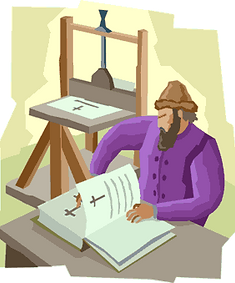
"You are not only responsible for what you say, but also for what you do not say."
-MARTIN LUTHER-
Reformation
The Protestant Reformation was the 16th-century religious, political, intellectual and cultural upheaval that splintered Catholic Europe, setting in place the structures and beliefs that would define the continent in the modern era. In northern and central Europe, reformers like Martin Luther, John Calvin and Henry VIII challenged papal authority and questioned the Catholic Church’s ability to define Christian practice. They argued for a religious and political redistribution of power into the hands of Bible- and pamphlet-reading pastors and princes. The disruption triggered wars, persecutions and the so-called Counter-Reformation, the Catholic Church’s delayed but forceful response to the Protestants.
The Reformation: Germany and Lutheranism
Martin Luther (1483-1546) was an Augustinian monk and university lecturer in Wittenberg when he composed his “95 Theses,” which protested the pope’s sale of reprieves from penance, or indulgences. Although he had hoped to spur renewal from within the church, in 1521 he was summoned before the Diet of Worms and excommunicated. Sheltered by Friedrich, elector of Saxony, Luther translated the Bible into German and continued his output of vernacular pamphlets.
When German peasants, inspired in part by Luther’s empowering “priesthood of all believers,” revolted in 1524, Luther sided with Germany’s princes. By the Reformation’s end, Lutheranism had become the state religion throughout much of Germany, Scandinavia and the Baltics.
The Reformation: Switzerland and Calvinism
The Swiss Reformation began in 1519 with the sermons of Ulrich Zwingli, whose teachings largely paralleled Luther’s. In 1541 John Calvin, a French Protestant who had spent the previous decade in exile writing his “Institutes of the Christian Religion,” was invited to settle in Geneva and put his Reformed doctrine—which stressed God’s power and humanity’s predestined fate—into practice. The result was a theocratic regime of enforced, austere morality.
Calvin’s Geneva became a hotbed for Protestant exiles, and his doctrines quickly spread to Scotland, France, Transylvania and the Low Countries, where Dutch Calvinism became a religious and economic force for the next 400 years.
The Reformation: England and the “Middle Way”
In England, the Reformation began with Henry VIII’s quest for a male heir. When Pope Clement VII refused to annul Henry’s marriage to Catherine of Aragon so he could remarry, the English king declared in 1534 that he alone should be the final authority in matters relating to the English church. Henry dissolved England’s monasteries to confiscate their wealth and worked to place the Bible in the hands of the people. Beginning in 1536, every parish was required to have a copy.
After Henry’s death, England tilted toward Calvinist-infused Protestantism during Edward VI’s six-year reign and then endured five years of reactionary Catholicism under Mary I. In 1559 Elizabeth I took the throne and, during her 44-year reign, cast the Church of England as a “middle way” between Calvinism and Catholicism, with vernacular worship and a revised Book of Common Prayer.
The Counter-Reformation
The Catholic Church was slow to respond systematically to the theological and publicity innovations of Luther and the other reformers. The Council of Trent, which met off and on from 1545 through 1563, articulated the Church’s answer to the problems that triggered the Reformation and to the reformers themselves.
The Catholic Church of the Counter-Reformation era grew more spiritual, more literate and more educated. New religious orders, notably the Jesuits, combined rigorous spirituality with a globally minded intellectualism, while mystics such as Teresa of Avila injected new passion into the older orders. Inquisitions, both in Spain and in Rome, were reorganized to fight the threat of Protestant heresy.
Johann Gutenberg & the Printing Press
A good cook can take leftovers and turn them into a delicious meal. Like a good cook, Johann Gutenberg took what had already been discovered, and created a small invention that changed history. Gutenberg created a machine that allowed him to move small blocks of letters in such a way that written material could be printed and mass-produced. Few people outside the clergy could read before Guttenberg invented the printing press, but once books became less expensive, literacy spread through Europe.
Block printing existed long before Gutenberg. The Chinese had been carving wood blocks to print books as early as 868, but their process had one major drawback; a new set of woodcuts had to be made for each book. Producing one book was difficult; producing a variety of books was not practical.
Writing ink dates from about 2500 BC in Egypt and China. The earlier cultures took soot from fires and mixed it with sap. Later civilizations used the dark blue indigo plant. Gutenberg used an oil-based printing ink that would last longer than other inks used in his time.
We don't know much about Gutenberg because he was not famous during his lifetime. He was born in Germany about 1400, and worked as a goldsmith. In 1448, Gutenberg developed engraved signatures for each number, letter, and punctuation mark. He then built the molds to hold the signatures in place, and borrowed money to purchase a press. Gutenberg published the first mass-produced book: a 1,282 page Bible. To this day, more copies of the Bible have been printed than any other book.
Copies of Gutenberg's invention spread throughout Europe, but the German goldsmith did not get rich from his invention. Patents did not yet exist, so anybody could build a printing press without compensating Gutenberg for his inspiration. Some religious and government officials denounced the invention of printing because they feared that it would spread bad ideas. But they were a minority. By 1500 there were 1,700 printing presses in Europe. The presses had already produced about 20 million volumes of 40,000 different books.






A page from the Giutenberg Bible.









